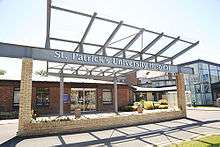St Patrick’s Mental Health Services
This article relates to St. Patrick's Mental Health Services in Ireland. For St. Patrick's Hospital in South Africa, please see St Patrick's Hospital (Eastern Cape).

St. Patrick's Mental Health Services is Ireland's leading not-for-profit mental health organisation, with over 700 staff members delivering 12% of the country’s total in-patient care and treatment needs.
Facilities
- 2 inpatient campuses: St Patrick’s University Hospital in Dublin 8 and St. Edmundsbury Hospital located in Lucan, that offer an array of services for adults with mood disorders, psychoses, addictions, anxiety disorders and eating disorders
- Adolescent mental health services at Willow Grove
- A Wellness & Recovery Centre that offers over 25 Day Services Programmes
- And Community Dean Clinics based in Dublin, Cork and Galway, providing a network of care accessible to people in every county in Ireland – with over 70,000 appointments since 2009.
Location
St. Patrick's University Hospital is located near Kilmainham and the Phoenix Park in Dublin. Its sister hospital, St. Edmundsbury is located in Lucan, County Dublin. [1][2]
Services
St. Patrick's provides a wide range of treatment programmes. These include programmes for mood disorders (depression and bipolar depression), anxiety disorder, an alcohol dependence / substance abuse programme, eating disorders, anorexia nervosa and bulimia, cognitive behavioural therapy, a young adult programme,[3] an adolescent service,[4] a dual diagnosis programme, a memory clinic and general mental health care.
It has departments of occupational therapy, social work, cognitive behavioural therapy, clinical psychology and psychiatry. It offers day hospital, outpatient, inpatient, and community mental health services.
It installed the first mental health Electronic Health Record in Ireland, using Servelec's eSwift EHR in September 2017.[5]
History
The hospital (originally St. Patrick's Hospital for Imbeciles)[6] was founded in 1747 with money bequeathed by Jonathan Swift following his death in 1745. He was keen that his hospital be situated close to a general hospital because of the links between physical and mental ill-health, so St. Patrick's was built beside Dr Steevens' Hospital. The architect was George Semple.[7]
In "Verses on the Death of Dr. Swift", the poet anticipated his own death:
He gave the little Wealth he had,
To build a House for Fools and Mad:
And shew'd by one satyric Touch,
No Nation wanted it so much:
That Kingdom he hath left his Debtor,I wish it soon may have a Better.[8]
Swift himself was declared of unsound mind by a Commission of Lunacy in 1742.[9][10] Will Durant said of him: "He went a whole year without uttering a word."[11]
The hospital retains Swiftian touches, with wards named after Stella (Esther Johnson), Vanessa (Esther Vanhomrigh), Henry Grattan, the village of Kilroot (in County Antrim) where Swift worked as Prebend at the church, and Laracor (County Meath) where he also worked as a clergyman.
The late Anthony Clare was medical director of St. Patrick's in the 1990s. Maurice Drury, a friend of Ludwig Wittgenstein, also worked there. The poet Austin Clarke was an in-patient in St. Patrick's for a year in 1919.
References
- ↑ St. Edmundsbury
- ↑ Dean Clinics
- ↑ young adult programme
- ↑ adolescent service
- ↑ "St Patrick's Mental Health Services launches first mental health EHR in Ireland". Digital Health. 23 November 2017. Retrieved 2 October 2018.
- ↑ Jonathan Swift. Retrieved: 2011-11-23.
- ↑ Elizabeth Malcolm, Swift's Hospital: A History of St Patrick's Hospital, Dublin, 1746-1989 (Dublin, 1989), 32.
- ↑ Verses On The Death Of Dr. Swift, D.S.P.D. Written by Himself Occasioned by reading a Maxim in Rochefoulcault. November 1731.
- ↑ Mental Health History Timeline. Retrieved: 2011-11-23.
- ↑ The Gentleman's Magazine, Volume XLIII, P. 468. 1855.
- ↑ "The Story of Civilization", V.8., 362.
External links
Coordinates: 53°20′39″N 6°17′33″W / 53.344208°N 6.292592°W